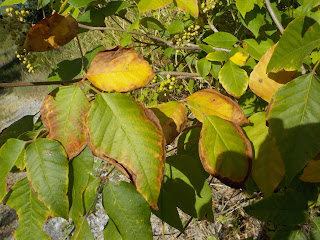This blustery winter afternoon (25 F & 25 mph N wind ) I went to the Woods to see how life was responding to an abrupt change from balmy winter days at 60 F.
Path to the NW pond passes quickly into the protected lee of the upper terrace. The force of the N wind drops away. First moment in the quiet of the lee, I disturb a barred owl that flies away southward from its perch above the pond. Perhaps watching for small prey coming to the water, or more likely, just sheltering from the wind.
The NW Pond has not frozen (yet) and as I stepped out to the edge, I saw
deep swirls in the water of some invisible vertebrate, probably a turtle on a last foraging opportunity before the night air chills to the low teens and the pond freezes over.
In the sedges at the southeast corner of the pond, a group of three large white-tailed deer stand and stare, only for a couple of seconds, before dashing away with their white tail flags flashing.
The Woods provides snug winter homes for many animals that can shelter deep back in earthen burrows or hidden in the protected core of old snags. Squirrels, mice, coyotes, raccoons, other fur bearers. Armadillos dig holes in the earth that everyone uses. Box turtles burrow deep into ravines full of fallen leaves and stay there all winter.
A pair of downy woodpeckers inspect old hackberries and flocks of robins are busy foraging, turning over leaves in search of arthropods, beetles, snails and any other small snacks they find before the dark and cold tonight. Where do they go then? Up into twiggy canopies protected from predators, or in some lower niche seeking protection from the wind? I don't know.
The forest floor is very, very dry from the months of little or no rain, The stronger than normal winds over the same time, have blown the dried leaves away from exposed bits of the trail. The soil there is bare, while three meters away, dry leaves sit in wind-blown piles. I wonder if soil fauna can migrate. As drier, colder winter days come, do they migrate downward into protected, warmer, moister layers? If so, how deep? Earthworms, but also, all the micro-arthropods, springtails, mites, tiny spiders, millipedes; and even smaller, the microbes. Do they move away from the drying cooling layers of the upper soil? Can microbes migrate inches? feet? or do they just go dormant, dry up, and produce resting stage spores to wait for warm spring rains?
Through the Woods, the blustery winds that blew all last night, have brought down more old branches broken in the October 2020 ice storm, that have been hanging dead, or broken and partly alive over the year plus. At the edge of the northern terrace, there are captured visions of violence. Large trees snapped, large boles shattered where other leaning trees have fallen and hit them. It might be interesting to census the Woods for broken trees. Which species are the strongest? Probably the big bur oaks. Which species are weaker? Pecans, cottonwoods, hackberries/ sugarberries. These grow plenty large, but are always dropping heavy limbs or sections of their main canopy. Ash, chittamwood and elms are tougher and do not splinter as readily when strong winds toss the trees, or bring them down.
Winter days are good days to see new patterns in the Woods. From up top of a fallen log I look out and see the large expanse of green wild 'onions' or chives' Allium around me. But this large irregular patch has a border. Inside the border, lots of green, outside the border, none. What makes the difference? What set the limit? Soil type? depth of silt or amount of sand? On one side closest to the Wash it is likely inundation, too much water, too long. A little farther south an almost equally large patch of dried grasses stands with foot high yellow stems above new green winter leaves. Again, the patch is defined, restricted, with a clear border. At the NW Pond a sharp border exists between the sedges and the cattails. What sets the border? If I were floating higher above the Woods 30-50 feet up, I could see sharp boundaries around different stands of trees. Green ash in the SW quarter. Willows in the SE quarter with a sharp border set by wet soil.. and maybe others where location is more random walnut, coffee trees, soapberry, wild plum, hickory, post oak, chittam. Are the invisible animals, the micro-arthropods similarly arranged in either well-defined locations or randomly scattered in a manner that is typical for that species? Probably so. Enough questions in the Woods to never know it all.


.jpeg)








